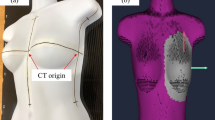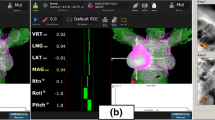Abstract
This study aimed to assess the feasibility of a skin marker–less patient setup using a surface-guided radiotherapy (SGRT) system for extremity radiotherapy. Twenty-five patients who underwent radiotherapy to the extremities were included in this retrospective study. The first group consisted of 10 patients and underwent a traditional setup procedure using skin marks and lasers. The second group comprised 15 patients and had a skin marker–less setup procedure that used an SGRT system only. To compare the two setup procedures for setup accuracy, the mean 3D vector shift magnitude was 0.9 mm for the traditional setup procedure and 0.5 mm for the skin marker–less setup procedure (p < 0.01). In addition, SGRT systems have been suggested to improve the accuracy and reproducibility of patient setups and consistently reduce interfractional setup errors. These results indicate that a skin marker–less patient setup procedure using an SGRT system is useful for extremity irradiation.





Similar content being viewed by others
Data availability
Due to the nature of this research, participants of this study did not agree for their data to be shared publicly, so supporting data are not available.
References
Gierga DP, Turcotte JC, Tong LW, et al. Analysis of setup uncertainties for extremity sarcoma patients using surface imaging. Pract Radiat Oncol. 2014;4(4):261–6. https://doi.org/10.1016/j.prro.2013.09.001.
Li XA, Qi XS, Pitterle M, et al. Interfractional variations in patient setup and anatomic change assessed by daily computed tomography. Int J Radiat Oncol Biol Phys. 2007;68:581–91. https://doi.org/10.1016/j.ijrobp.2006.12.024.
Dickie CI, Parent AL, Chung PW, et al. Measuring interfractional and intrafractional motion with cone beam computed tomography and an optical localization system for lower extremity soft tissue sarcoma patients treated with preoperative intensity-modulated radiation therapy. Int J Radiat Oncol Biol Phys. 2010;78:1437–44. https://doi.org/10.1016/j.ijrobp.2009.09.054.
Radiotherapy Kataroukai. Working group for standardizing skin marking. https://drive.google.com/file/d1qpgpCqZJOcG8V2VBbClHOdx5V8lE2d6m/view. (Accessed date Oct 2021)
Asada H, Takahashi Y, Ono Y, et al. Emotional experiences of skin markings among patients undergoing radiotherapy and related factors: a questionnaire-based cross-sectional study. Patient Prefer Adherence. 2022;16:1359–69. https://doi.org/10.2147/PPA.S361916.
Stanley DN, McConnell KA, Kirby N, et al. Comparison of initial patient setup accuracy between surface imaging and three point localization: a retrospective analysis. J Appl Clin Med Phys. 2017;18(6):58–61. https://doi.org/10.1002/acm2.12183.
Hoisak JDP, Pawlicki T. The role of optical surface imaging system in radiation therapy. Semin Radiat Oncol. 2018;28(3):185–93.
Rigley J, Robertson P, Scattergood L. Radiotherapy without tattoos: could this work? Radiography. 2020;26:288–93. https://doi.org/10.1016/j.radi.2020.02.008.
Batin E, Depauw N, MacDonald S, et al. Can surface imaging improve the patient setup for proton postmastectomy chest wall irradiation? Pract Radiat Oncol. 2016;6(6):e235–41. https://doi.org/10.1016/j.prro.2016.02.001.
van Herk M, Remeijer P, Rasch C, et al. The probability of correct target dosage: dose-population histograms for deriving treatment margins in radiotherapy. Int J Radiat Oncol Biol Phys. 2000;47:1121–35. https://doi.org/10.1016/S0360-3016(00)00518-6.
Ling CC, Yorke E, Fuks Z. From IMRT to IGRT: Frontierland or Neverland? Radiother Oncol. 2006;78:119–22. https://doi.org/10.1016/j.radonc.2005.12.005.
Islam MK, Purdie TG, Norrlinger BD, et al. Patient dose from kilovoltage cone beam computed tomography imaging in radiation therapy. Med Phys. 2006;33:1573–82. https://doi.org/10.1118/1.2198169.
Freislederer P, Batista V, Ollers M, et al. ESTRO-ACROP guideline on surface guided radiation therapy. Radiother Oncol. 2022;173:188–96. https://doi.org/10.1016/j.radonc.2022.05.026.
Yamaguchi H, Matsumoto M, Ohta S, et al. Analysis of statistical significance for difference of setup error between staff and new face in radiotherapy. Nihon Hoshasen Gijutsu Gakkai Zasshi. 2012;68(5):602–7. https://doi.org/10.6009/jjrt.2012_JSRT_68.5.602.
Greer PB, Mortensen TM. Anterior-posterior treatment localization in pelvic radiotherapy: tattoos or fixed couch-to-isocenter distance. Med Dosim. 1997;22:43–6. https://doi.org/10.1016/S0958-3947(96)00156-2.
Elsner K, Francis K, Hruby G, et al. Quality improvement process to assess tattoo alignment, set-up accuracy and isocentre reproducibility in pelvic radiotherapy patients. J Med Radiat Sci. 2014;61(4):246–52. https://doi.org/10.1002/jmrs.79.
Nguyen N-TA, Roberge D, Freeman CR, et al. Skin elasticity as a measure of radiation fibrosis: is it reproducible and does it correlate with patient and physician-reported measures. Technol Cancer Res Treat. 2014;13:469–76.
Japanese Society of Radiological Technology. Radiotherapy Division. Journal of Radiotherapy Section. 202236(2):49-58; https://jsrt.or.jp/data/wp-content/uploads/2022/10/3tiryou_2022_10_secure.pdf. (Accessed date Apr 2022)
Jimenez RB, Batin E, Giantsoudi D, et al. Tattoo free setup for partial breast irradiation: a feasibility study. J Appl Clin Med Phys. 2019;20:45–50. https://doi.org/10.1002/acm2.12557.
Naidoo W, Leech M. Feasibility of surface guided radiotherapy for patient positioning in breast radiotherapy versus conventional tattoo-based setups– a systematic review. Tech Innov Patient Support Radiat Oncol. 2022;22:39–49. https://doi.org/10.1016/j.tipsro.2022.03.001.
Sasaki M, Matsushita N, Fujimoto T, et al. New patient setup procedure using surface-guided imaging to reduce body touch and skin marks in whole-breast irradiation during the COVID-19 pandemic. Radiol Phys Technol. 2023;16:422–9. https://doi.org/10.1007/s12194-023-00735-0.
Author information
Authors and Affiliations
Corresponding author
Ethics declarations
Conflict of interest
The authors declare that they have no conflicts of interest.
Ethical approval
All procedures involving human participants were performed in accordance with the ethical standards of the institutional research committee and the 1964 Helsinki Declaration and its later amendments. This study was approved by the Institutional Review Board of Chiba Cancer Center on June 23, 2023 (approval number: R05-127).
Informed consent
Informed consent was obtained from the opt-out option on our institution’s website. The patients’ right to privacy was preserved by anonymizing their data.
Additional information
Publisher's Note
Springer Nature remains neutral with regard to jurisdictional claims in published maps and institutional affiliations.
About this article
Cite this article
Yamashita, K., Shimizu, T., Miyabayashi, K. et al. Utility of a skin marker–less setup procedure using surface-guided imaging: a comparison with the traditional laser-based setup in extremity irradiation. Radiol Phys Technol 17, 569–577 (2024). https://doi.org/10.1007/s12194-024-00806-w
Received:
Revised:
Accepted:
Published:
Issue Date:
DOI: https://doi.org/10.1007/s12194-024-00806-w




